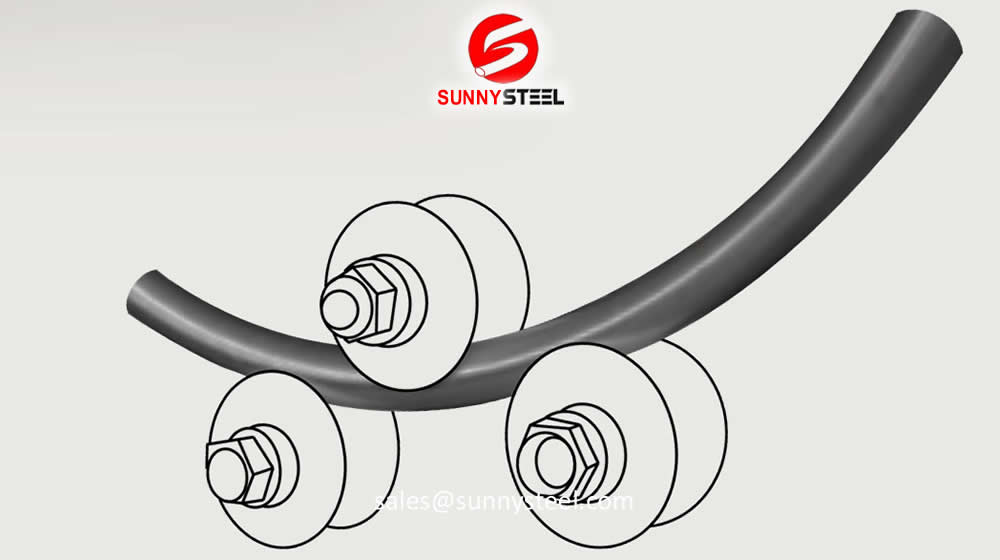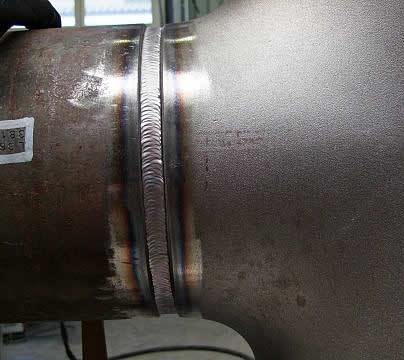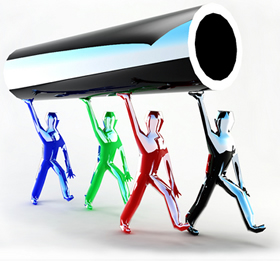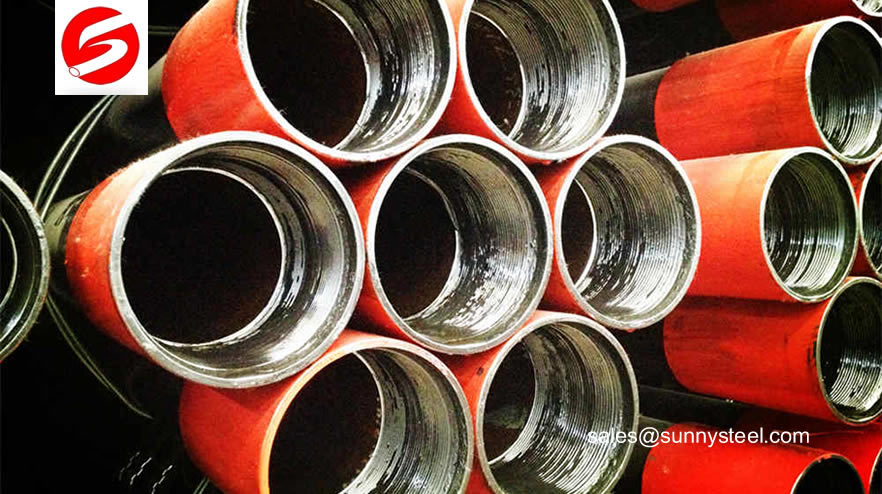Butt weld pipe fittings allow for changing the direction of flow, reducing pipe sizes and attaching auxiliary equipment.
A common example using welded pipe fitting is a pipe reduced by concentric reducer, welded to a weld neck flange and connected to an equipment. Figure below represent complete collection of butt welded pipe fitting.
Pipe elbows
Pipe elbows are used to be installed between two lengths of pipe or tube allowing a change of direction,usually these elbows distinguished by connection ends.Pipe bending
The pipe bending is used to change the direction of run of pipe.Pipe reducer
Pipe Reducers are the component in a pipeline that reduces the pipe size from a larger to a smaller bore (inner diameter).End Caps
End caps are usually used for protecting the end of pipe and other fittings, so the shape are designed according to the shape of pipe line.Stub end
Stub ends are buttweld fittings that can be used alternatively to welding neck flanges to make flanged connections.Pipe cross
A pipe cross is a kind of pipe fitting that be used in the place where four pipes meet together.Saddle previously
Saddle previously is the ventilation ducts 'crotch tee', its shaped like pants, there Equal and unequal diameter, the formal name is "tube tapered pants tee."Pipe tee
Pipe Tee is a type of pipe fitting which is T-shaped having two outlets, at 90° to the connection to the main line.Benefits of Butt Weld Pipe Fittings
The benefit to using a butt weld fitting is that it doesn’t leak. Because the butt weld is welded directly to pipe and not simply bolted together, it is not only much stronger than a typical fitting, but it allows for better flow through the system with less resistance to friction. Welded fittings also allows for better layout designs through key features such as being more compact and greater in strength.
General standard of fittings
ASTM A234/ASME SA234M
Standard Specification for Piping Fittings of Wrought Carbon Steel and Alloy Steel for Moderate and High Temperature ServiceASTM A420
Standard Specification for Piping Fittings of Wrought Carbon Steel and Alloy Steel for Low-Temperature ServiceASTM A403
ASTM A403 Standard specification covers the standard for wrought austenitic stainless steel fittings for pressure piping applications.ASME B16.9
ASME B16.9 Standard covers overall dimensions, tolerances,ratings, testing, and markings for factory-made wrought buttwelding fittingsASME B16.28
ASME B16.28 Standard covers ratings, overall dimensions, testing, tolerances, and markings for wrought carbon and alloy steel buttwelding short radius elbows and returns.ANSI/ASME B16.25
ANSI/ASME B16.25 Standard covers the preparation of butt welding ends of piping components to be joined into a piping system by welding.MSS SP-97
This Standard Practice covers essential dimensions, finish, tolerances, testing, marking, material, and minimum strength requirements for 90 and 45 degree integrally reinforced forged branch outlet fittings of buttwelding, socket welding, and threaded types.How a Butt Weld Fitting is Made?
Buttweld pipe fittings comprises of long radius elbow, concentric reducer, eccentric reducers and Tees etc. Butt weld stainless steel and carbon steel fittings are an important part of industrial piping system to change direction, branch off or to mechanically join equipment to the system. Buttweld fittings are sold in nominal pipe sizes with specified pipe schedule. BW fitting’s dimensions and tolerances are defined as per ASME standard B16.9.
A butt weld pipe fitting is made by the process of hot forming that includes bending and forming to shape. The starting material of butt weld fitting is a pipe that is cut to length, heated and molded into specific shapes by means of dies. Heat treatment is also done to remove residual stresses and obtain desired mechanical properties.
There are numerous processes for manufacturing butt weld fittings, several examples listed as follows.
TEES:
Extrusion method (Hot Forming)
The hot-extrusion process consists of enclosing a piece of metal, heated to forging temperature, in a chamber called a "container" having a die at one end with an opening of the shape of the desired finished section, and applying pressure to the metal through the opposite end of the container.
ELBOWS:
Mandrel method (Hot Forming)
One of the most common manufacturing methods for manufacturing Elbows from pipes. After heating the raw material, it is pushed over a die called "mandrel" which allows the pipe to expand and bend simultaneously.
CAPS:
Deep Drawing method
One of the most common manufacturing methods for caps, where plate is cut out in a circle and formed by deep drawing.
Deep drawing is the manufacturing process of forming sheet metal stock, called blanks, into geometrical or irregular shapes that are more than half their diameters in depth. Deep drawing involves stretching the metal blank around a plug and then moving it into a moulding cutter called a die.
A drawing press can be used for forming sheet metal into different shapes and the finished shape depends on the final position that the blanks are pushed down in. The metal used in deep drawing must be malleable as well as resistant to stress and tension damage.
Forging may be performed under hammers, in mechanical presses and upsetters or by a method known as roll forging. Pressing generally includes the manufacture of forged articles in hydraulic presses. Extrusion usually is performed in hydraulic presses which force the hot steel through a die. Rolling is performed in rolling mills of a variety of types.
The two principal reasons for perform metal forming at elevated temperatures (hot working) are to reduce the forming loads through the reduction of the resistance of the steel to deformation, and to develop preferred metallurgical structures for strength and ductility of the finish products. The most appropriate manufacturing method of a product will be decided with consideration of its material, sizes, shape, use, standards and other properties.
Recommended pipe fittings
We will help you put together your entire project and ship it to your closest port.
Butt weld fittings and their applications
Pipe fittings come in many forms with the most common being threaded fittings, socket weld fittings and buttweld fittings. This blog will explore the advantages of all three types, but especially the advantages of buttweld fittings and their applications.
Pipe fittings are essential parts of pipelines as they allow for the following:
- A change in direction for the liquid flowing through the pipes
- Branching of the pipe to allow the liquid to flow in two separate directions
- A reduction in pipe diameter
- The attachment of auxiliary equipment
- The end of the pipeline
All the buttweld fittings supplied by Special Piping Materials are designed in accordance to ASME standards.

- Chemical / Petrochemical
- Municipal
- Food, Beverage, and Dairy
- Oil and Gas
- Power

- Process Instrumentation
- Pulp and Paper
- Semiconductor
- Marine & dredging
- Sanitation

- Flanges Used in Piping Systems
- Irrigation
- Residential
- Road & highway construction
- Ventilation etc
Advantages:
Buttweld fittings can withstand pressures and temperatures in very harsh environments. They are generally considered to be the most robust welding fixture, no matter what industry it is required for. However, they do take a considerable time to fit and a highly skilled installer is required to weld them correctly on site.
- Welded connection offers a more robust, a stronger and a more leak-proof piping connections.
- The nature of the continuous metal structure provides added strength to the overall piping system.
- The smooth inner surface and gradual directional changes provide a seamless flow, thus minimising pressure drops and turbulence inside the pipe.
- Provide the option of various different turn radiuses due to the manufacture of Short Radius fittings, Long Radius fittings and 3R Elbows.
- They are cost effective compared to the counterpart fittings in the threaded or socket weld varieties.
- They have a long service life and are cost effective to purchase and deploy.
- Buttweld fittings can withstand corrosion and erosion more effectively than its socket weld and threaded equivalents.
- A welded system uses comparatively less space that the other alternatives.
Abrasion resistant Pipe fittings
Alumina ceramics have been developed and optimized for maximum wear resistance and corrosion resistance.

Fittings FAQs:
These fittings are the most common type of welded pipe fitting and are specified by nominal pipe size and pipe schedule. Buttweld fittings use seamless or welded pipe as the starting material and are forged (through multiple process) to get he shape of elbows, tees and reducers etc.
Benefits of welded fittings
The allowable pressure ratings for fittings designed in accordance with the standard ASME B 16.9–1993 may be calculated as for straight seamless pipe in accordance with the rules established in the applicable section of the ASME B 31 codes for pressure piping.
- are strong and leak-proof
- minimize the pressure drops and the turbolence along the pipeline
- have a long service life
How are pipe fittings measured ?
- (Fittings are also defined by their material grade and whether they are welded or seamless.)
- Diameter refers to outside diameter of a pipe or fitting.
- The North American standard is known as Nominal Pipe Size (NPS). The International Standard is known as Diameter Nominal (DN). Pipes and fittings are actually made in similar sizes around the world: they are just labeled differently.
- From ½ in to 12 inch “Nominal Pipe Size”, outside diameters are slightly larger than indicated size; inside diameters get smaller as schedules grow.
- From 14 in and larger “Nominal Pipe Size”, outside diameters are exactly as indicated size; inside diameters get smaller as schedules grow.
- As with other North American standards (inch, foot, yard, mile, …), many pipe standards (diameters up to 12 inch and wall thickness) are based on historical precedents (a toolmaker’s dies during US Civil War) rather than a “scientific” method.
Why are fittings sometimes thicker and heavier than pipes to which they are connected ?
Fittings are sometimes thicker than their connecting pipes to meet performance requirements or due to manufacturing reasons.
- Due to fitting geometry, stress is very different when compared to a pipe.
- Using extra material is often necessary to compensate for such additional stress, especially for tees and tight curve elbows.
- Fitting manufacturers may not always stock plates or pipes for all metal grades or sizes.
- When responding to an order, manufacturers always use the right metal or alloy, but sometimes made with next-higher available plate or pipe size while still respecting specified inside diameters.
What does “schedule” mean for pipe fittings ?
As the main function of the pipes is to carry fluid under pressure therefore their internal diameter is their critical dimension. This critical dimension is referred to as the nominal bore (NB). Obviously, for pipes containing pressurised fluids the wall thickness, and by implication the pipe’s strength, is important. Wall thickness is expressed in “schedules“, referred to as pipe schedules. The pipe schedule is abbreviated as SCH.
Nominal Pipe Size (NPS) is a North American set of standard sizes for pipes used for high or low pressures and temperatures.
- Schedule, often shortened as sch, is a North American standard that refers to wall thickness of a pipe or pipe fitting. Higher schedules mean thicker walls that can resist higher pressures.
- Pipe standards define these wall thicknesses: SCH 5, 5S, 10, 10S, 20, 30, 40, 40S, 60, 80, 80S, 100, 120, 140, 160, STD, XS and XXS. (S following a number is for stainless steel. Sizes without an S are for carbon steel.)
- Higher schedules are heavier, require more material and are therefore more costly to make and install.
What does 45 SR or 90 LR mean for pipe fittings ?
By default, there are 5 opportunities, the 45°, 90° and 180° elbows, all three in the "long radius" version, and in addition the 90° and 180° elbows both in the "short radius" version.
- 45 and 90 refer to angles for changing direction of pipe flows: 45 degrees or 90 degrees. Most elbows are 45˚ or 90˚.
- SR means Short Radius; LR means Long Radius. Centerline radius of long radius (LR) elbows is smoother than of short radius (SR).
- In SR fittings, radius equals nominal diameter size. A 6 inch pipe will have a 6 inch radius center-to-end, giving it a sharp curve.
- In LR fittings, radius equals 1.5x nominal diameter size. A 6 inch pipe will have a 9 inch centerline radius, for a smoother curve than SR.
Differentiate between SCH 40 & True Schedule 40
Pipe fittings 12 inch or larger require specifying if fitting is standard wall (most commonly referred to sch 40) or a true schedule 40 is required.
This is needed since schedule 40 do NOT correspond to standard wall for pipe sizes 12” and bigger. A true sch 40 will be thicker than standard wall for pipe fittings 12” or bigger.
Differentiate between SCH 80 & True Schedule 80:
For pipe sizes 10 in and above, sch 80 do NOT correspond to XH. Customer must specify if they want SCH 80 or XH wall.
What is the difference between a 3R and a 3D elbow?
There is no difference between 3R and 3D.
- Both have a centerline radius of three times the nominal diameter size.
- Both have a smoother curve than an SR or LR.
- (In fittings, 3D does not refer to modeling software or screens.)
What is the difference between concentric and eccentric reducers ?
A reducer is the component in a pipeline that reduces the pipe size from a larger to a smaller bore (inner diameter).
- Concentric reducer is symmetrical both ends are aligned along the center.
- Eccentric reducer is not symmetrical ends are off center of one another.
What is a lateral pipe fitting ?
A lateral separates one line into two; the second line branches at a 45˚ angle.
The WYE have two branch pipes at a 45 degree angle between them,and the two branch pipes are symmetrical to the centerline of the inflow pipe which means the two outflow direction are both at 22.5 degree to the inflow direction.
What is a seamless butt weld fitting?
A seamless butt weld pipe fitting is made directly from a section of seamless pipe material, by applying heat and pressure to transform pipe directly into an elbow or other shape.
A seamless fitting has no welded parts by itself, a characteristic demanded in some critical applications.
By comparison, a regular butt weld fitting has one, two or more welds, depending on dimension, shape and manufacturing method.
No weld means less risk of weld yield and porosities.
What is PVF?
PVF means Pipe, Valve and Fittings, and is widely used as short-hand to describe this industry.
PVFs can be made in a variety of metals or plastics.
Manufacturers typically specialize in special types of materials; distributors can carry narrow or very broad product lines.
LR or SR elbow to use?
L/R - Long radius, S/R - Short radius
- The short radius elbow is used in tight areas, while the long radius is used under normal working conditions.
- The long radius elbow is better than short radius elbow when it is scoured and worn.
- The position of the two elbows should be determined according to the practical conditions, because the positions are necessary.
- The reducing elbow eliminates one pipe fitting and reduces the welding by more than one-third.
Elbows are design features as below
- 90 Degree Elbow – where change in direction required is 90°
- 45 Degree Elbow – where change in direction required is 45°
ELL & ELLS
- A wing of a building at right angles to the main structure.
- A right-angled bend in a pipe or conduit; an elbow.
” All bends are elbows but all elbows are not bends.”
Infact, the pipe is bent to form an elbow.
Elbows are pre-fabricated and are firm in design.
There are issues with bends since the tickness at the bend radius reduces as we bend the pipe.
Bends typically have a minimum bending radius of 1.5 times pipe radius (R). If this bending radius is less than 1.5R, it is called Elbow. Reference to any international / industry standard need to be traced. 1.5, 3 and 4.5 R are the most common bending radii in industry.
An elbow is also typically a sharp 90 degrees and often is a separate piece.
Sharp bends are normally called Elbows.
An elbow is also typically a sharp 90 degrees and often is a separate piece.
A bend is typically of the same material and typically a more gentle bend to prevent kinking.
A bend typically flows smoother since there are not irregular surfaces on the inside of the pipe, nor does the fluid have to change direction abruptly.
The most basic difference of them is the elbow relatively short than bend, R = 1D to 2 D is elbow More than 2D is bend. In the production process, cold bends can use Bending Machine to bend by ready-made straight bend. One-time completed also don’t need second corrosion. But elbow need manufacturers make to order, to do anti-corrosion, order cycle is long. Elbow price is higher than bend. But cost performance is much higher than bend. It is well-known that bend do not have anticorrosive processing is easy damaged, but the price is cheap so are used very much in some demand which not very high engineering.
In the west-east gas transmission of course, cold bends cost is low. elbow need manufacturers make to order, needs corrosion, order cycle is long,but cold bends can use ready-made straight bend by Bending Machine to bend. One-time completed also don’t need second corrosion. The cold bend construction technology need follow oil standard .west-east gas transmission have the enterprise standard,but we can use either elbow nor bend in open area. Sunny Steel Enterprise warn broad customers betweenness elbow and bend performance price is differ ,please carefully choose after consider it.
Elbow angle can be easily calculated using simple geometrical technique of mathematics.
Elbow Radius:
Elbows or bends are available in various radii for a smooth change in direction which are expressed in terms of pipe nominal size expressed in inches. Elbows or bends are available in three radii,
a. Long radius elbows (Radius = 1.5D): used most frequently where there is a need to keep the frictional fluid pressure loss down to a minimum, there is ample space and volume to allow for a wider turn and generate less pressure drop.
b. Long radius elbows (Radius > 1.5D): Used sometimes for specific applications for transporting high viscous fluids likes slurry, low polymer etc. For radius more than 1.5D pipe bends are usually used and these can be made to any radius.However, 3D & 5D pipe bends are most commonly used
b. Short radius elbows (Radius = 1.0D): to be used only in locations where space does not permit use of long radies elbow and there is a need to reduce the cost of elbows. In jacketed piping the short radius elbow is used for the core pipe.
Here D is nominal pipe size in inches.
There are three major parameters which dictates the radius selection for elbow. Space availability, cost and pressure drop.
Pipe bends are preferred where pressure drop is of a major consideration.
Use of short radius elbows should be avoided as far as possible due to abrupt change in direction causing high pressure drop.
Minimum thickness requirement:
Whether an elbow or bend is used the minimum thickness requirement from code must be met. Code ASME B 31.3 provides equation for calculating minimum thickness required (t) in finished form for a given internal design pressure (P) as shown below:
R1 = bend radius of welding elbow or pipe bend
D = outside diameter of pipe
W = weld joint strength reduction factor
Y = coefficient from Code Table 304.1.1
S = stress value for material from Table A-1 at maximum temperature
E = quality factor from Table A-1A or A-1B
Add any corrosion, erosion, mechanical allowances with this calculated value to get the thickness required.
End Connections:
For connecting elbow/bend to pipe the following type of end connections are available
- Butt welded: Used alongwith large bore (>=2 inch) piping
- Socket welded: Used alongwith pipe size
- Screwed
- Flanged
Butt welded Elbows:
- Pipe is connected to butt welded elbow as shown in Fig. 4 by having a butt-welding joint.
- Butt welded fittings are supplied with bevel ends suitable for welding to pipe. It is important to indicate the connected pipe thickness /schedule while ordering. All edge preparations for butt welding should conform to ASME B16.25.
- Dimensions of butt welded elbows are as per ASME B16.9. This standard is applicable for carbon steel & alloy steel butt weld fittings of NPS 1/2” through 48”.
- Dimensions of stainless steel butt welded fittings are as per MSS-SP-43. Physical dimensions for fittings are identical under ASME B16.9 and MSS-SP-43. It is implied that the scope of ASME B16.9 deals primarily with the wall thicknesses which are common to carbon and low alloy steel piping, whereas MSS-SP-43 deals specifically with schedule 5S & 10S in stainless steel piping.
- Dimensions for short radius elbows are as per ASME B16.28 in case of carbon steel & low alloy steel and MSS-SP-59 for stainless steel.
- Butt welded fittings are usually used for sizes 2” & above. However, for smaller sizes up to 1-1/2” on critical lines where use of socket welded joints is prohibited, pipe bends are normally used. These bends are usually of 5D radius and made at site by cold bending of pipe. Alternatively, butt welded elbows can be used in lieu of pipe bends but usually smaller dia lines are field routed and it is not possible to have the requirement known at initial stage of the project for procurement purpose. So pipe bends are preferred. However, pipe bends do occupy more space and particularly in pharmaceutical plants where major portion of piping is of small dia. and layout is congested, butt welded elbows are preferred.
- Butt welded joints can be radiographed and hence preferred for all critical services.
Elbows are split into two groups which define the distance over which they change direction; the center line of one end to the opposite face.
This is known as the "center to face" distance and is equivalent to the radius through which the elbow is bent.
Here below, for example, you will find the center to face distance of NPS 2 elbows (the A distance on the image)
- 90°-LR : = 1½ x 2(NPS) x 25.4 A=76.2 mm
- 180°-LR : = 2 times the 90° LR elbow A=152.4 mm
- 90°-SR : = 2(NPS) x 25.4 A=50.8 mm
- 180°-SR : = 2 times the 90° SR elbow A=101.6 mm
The center to face distance for a "long" radius elbow, abbreviated LR always is "1½ x Nominal Pipe Size (NPS) (1½D)", while the center to face distance for a "short" radius elbow, abbreviated SR even is to nominal pipe size.






























































